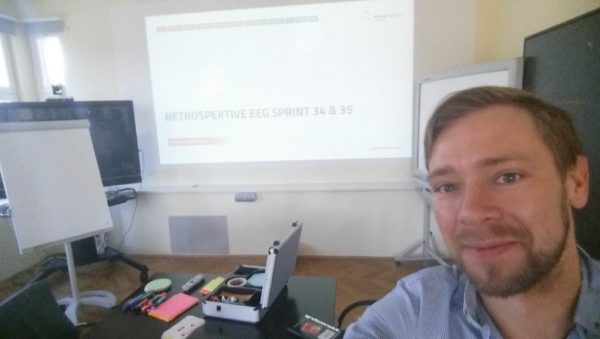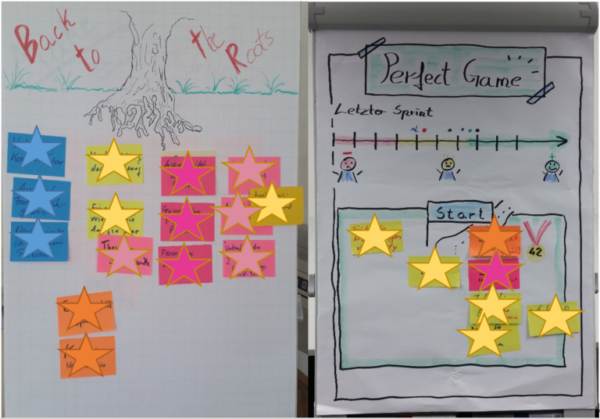In my blog post I describe my path to becoming a Scrum Master and show, how exactly such a role change can look like. I will give you some tips to help you on your way and I hope it is also entertaining.

Many of us will know: A new project begins, new colleagues come up to you, new networks, tools, and so on. As a consultant you start getting to know your new environment. As a specialist I will do a good job, despite the new variables. It always gets interesting when I leave my specialist role behind and therefore leave my comfort zone. So how about slipping into a new task at this point? A role that can and should indirectly influence the project team?
First sprint: All beginnings are hard or what was that?
Initially restless nights were to be expected. Many questions and ideas all around the Scrum Master are in the air: Where do I begin with my work? What is the team thinking about it? What the hell am I exactly supposed to do?
There is something good about having so many thoughts in your head – apart from missing sleep. All the questions I have asked myself, I would like to have answered.
Tip 1: Clarify open questions as soon as possible to gain more and more security.
By now I can say, you do not have to answer all questions alone. Support will be given upon request.

Second sprint: The preparation phase
I was able to acquire the theoretical knowledge for my new task quite fast by using podcasts, blogs, and professional journals.
Theory is good and sets the foundation but without practical utilisation it is not worth much. Values like trust and empathy have a greater importance in this role. What you must be aware of is that you as a Scrum Master cannot really make a difference without the team. This is where I wanted to start and put my focus on. Maybe I could get into conversation with colleagues from the new project earlier.
Tip 2: It is no problem to openly admit that you have not yet completed x projects as a Scrum Master.
It possibly might incite the team to take the new paths together.
Third sprint: The start
My work begins with the introduction in the team. As described in sprint 2 I already did that. So first and foremost, it was about what I would contribute for the team. Words like organizer, moderator, supporter, and a few others fell. I was not very surprising. In sprint 1 and 2 those expressions were used a lot when it comes to the duties of a Scrum Master.
The next step was about applying all the information I have read and heard in my everyday working live. Here I definitely needed people with experience in this domain – contact persons that guided me throughout the first time. At this point my thanks again to my coach Ines. I was able to join first reviews and plannings followed by an evaluation and coaching. Slowly I got an idea of what I was heading for.
One of the first lectures I read in the beginning was “Was macht der Scrum Master den ganzen Tag“(German for “What does the Scrum Master do all day”) from Henning Wolf. Soon I could put this reading aside. It was much more than I thought.
Tip 3: Do not just ask yourself as Scrum Master the following question in the beginning, but in every iteration: “What did I contribute to make out team better?“
Fourth Sprint: Do It!
In my first days as a Scrum Master it was my task to create the foundation for improvements in the team. By closely working together with the Business Analysts (supporters of the product owner on the client side) and the team, we were able to identify open issues quickly. The end in which I was jumped was not as deep here. Step by step we optimised schedule chains, adapted processes, and worked out new ideas with the team, which should move us forward in our work. In addition to the organisational aspects, my first retrospective was also on the agenda. I think you can imagine that this was a pretty exciting date for me.
While the first attempts at the flipchart looked rather, well let us say, “modest”, it got better and better over time.

Tip 4: Visit a flipchart coaching if you have the opportunity – even just a few tricks can improve your presentation considerably.
Fifth sprint: Conclusion
I don’t find it hard to answer the question of Henning Wolf “Was macht der Scrum Master den ganzen Tag“(German for “What does the Scrum Master do all day”) mentioned before. It is a constant challenge for the Scrum Master and therefore for me to provide optimal support for the team and to continuously develop myself further. I was able to successfully complete my certification “CSM”, but this was certainly not the last milestone.
I am looking forward to all the things to come in my new role and of course to further Scrum Masters colleagues 😉 So if you are interested in supporting our team as a Scrum Master in the future, please contact our staff team at jobs.digitalinnovation@zeiss.com.